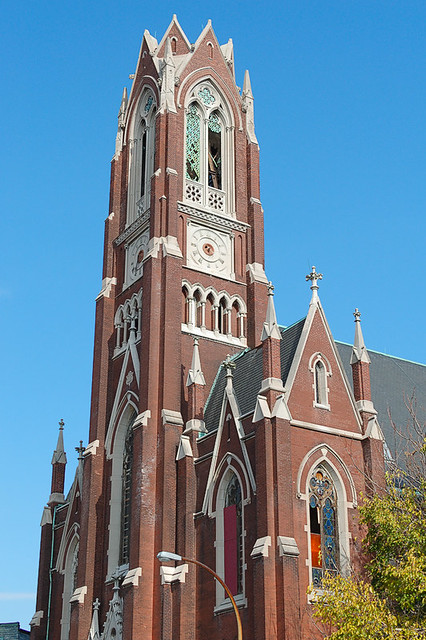|
May 03, 2012
MAY CROWNING
OBLATE RETREAT - UPCOMING PRIESTLY RETREAT
CHAPEL RENOVATION (ALMOST) FINISHEDCO-OP THEATER - BANNERS
CHOIR CAMP - PARISH HISTORY
Dear Faithful and Friends of St. Francis de Sales Oratory,
MAY CROWNING THIS SUNDAY, MAY 06
 Canon Matthew Talarico
Canon Matthew Talarico
The Oratory will have the pleasure of welcoming Canon Matthew Talarico, Substitute for the Provincial in the United States. He will be the celebrant and homilist of both Masses this Sunday, May 6, and will also crown the statue of Our Lady (May Crowning). Please come to greet Canon Talarico after Mass in the hall.
OBLATE RETREAT
 Canon von Menshengen with the Oblates of the US Province
Canon von Menshengen with the Oblates of the US Province
This week the Oratory hosts four oblates (in cassock) who serve in the US Province in various apostolates, and two candidates for the oblatehood. The occasion is the annual retreat for oblates of the Institute, preached this year by Canon von Menshengen from the Institute apostolate in Arizona. We at the Oratory are very pleased to acknowledge two familiar members of this retreat: Abbe Alex Barga, who has faithfully served the Oratory, and Mr. Matthew Serafino, a new candidate for the oblatehood.

The Institute is blessed with quite a number of young men who have a strong vocation to the community life, without a calling to serve the Lord as priests. As full members of the Institute, our oblates work closely with our priests, dedicating their many and varied talents to serve in our apostolates. As we know well at St. Francis de Sales, their role is so indispensable that they are sometimes called the “guardian angels of the priest.” With gratitude for their service to the Church and to the Institute, please join us in welcoming them to the Oratory, and offering prayers for their vocation.
PRIESTLY RETREAT MAY 21-25

In addition to the oblate retreat this week, St. Francis de Sales Oratory again will have the privilege of hosting all of the Institute priests serving the US Province for the annual retreat during the week of May 21-25. As in previous years, Monsignor Gilles Wach, Prior General and founder of the Institute, will come to preach. Like the annual Chapter Meeting, this gathering is an important event in the community life of the Institute, and an anticipated event which we all look forward to. We are deeply grateful for the help and support of the faithful here in St. Louis, as we plan for the arrival of all our priests from many parts of the United States. Please pray for us, and be assured of the Institute’s prayers of gratitude for your continuous generosity.
 
There will be a Solemn High Mass on Thursday, May 24, at 6:30 PM, with Monsignor Wach as celebrant. After the Mass all faithful in attendance are cordially invited to greet Monsignor and all canons of the American Province at the hall during a short reception.
CHAPEL RENOVATION
In part to prepare for the upcoming priestly retreat, the renovation of the chapel inside the convent was accelerated so that we will be able to efficiently accommodate the private daily Masses every priest celebrates. Thanks to the extraordinarily generous and capable efforts of many faithful, the chapel is gleaming with newly painted walls, a new ceiling, light fixtures, “crown-molding” and soon beautiful curtains. Every minute of work which has gone into producing the beautiful chapel will be amply rewarded in the Holy Sacrifice which will take place there. Deo gratias!
CO-OP SENIOR DRAMA CLASS

Dear Senior Drama Families,
Thank you very much for all your wonderful work here!
It is true that we should be very proud of this group of students: What they have offered to all of us is the fruit of great perseverance, love and hard work. It is, first of all, a great compliment to you, dear families, parents and siblings, since last weekend’s performances show the effectiveness of a balanced and competent home-schooling practice and harmonious family life. It was gratifying to meet young adults who are socially and academically much more "skilled" and "apt" than one might expect. What we were happy enough to see is at the same time a beautiful fruit of the spiritual treasures Saint Francis de Sales (the patron saint and the oratory) is providing for all of us.
Thank you all very much, especially Mr. and Mrs. Schmidt, Dr. and Mrs. Dickinson and Mr. and Mrs. Hayworth, for all they do!
NEW STREET BANNERS
 View from Iowa Street
View from Iowa Street
In 2005 when the Oratory was first erected by then Archbishop Burke, vertical pole banners were installed along the side walk around the Oratory on Iowa, Lynch Streets and Ohio Avenue. With time, these banners deteriorated in the hot and cold weather, in the wind and the rain. In the last month, these old banners were replaced with bold blue ones carrying the crest of the Institute, and white ones proclaiming the name of the Oratory: St. Francis de Sales. May Our Lady the Immaculate Conception and our patron St. Francis de Sales continue to guide this church to be the cornerstone of revival for this neighborhood.
CHOIR CAMP 2012

This summer, the Institute will once again offer a week-long music camp for the children to hone their music skills in an atmosphere of friendship and camaraderie at the Ursuline Motherhouse in Kentucky, from August 5th-10th. Immersed in daily music making with their peers, the campers will attend classes in Latin, Gregorian Chant, Music Theory, and Vocal Technique. Daily Mass in the Extraordinary Form of the Roman Rite will be offered by an Institute priest. This year's faculty includes: Mr. Nick Botkins (Director of Sacred Music - Saint Francis de Sales Oratory), Mr. Kevin Allen, (Composer, Chicago) , and Ms. Yollanda Bornhoff (Organist, Chicago).
Since our announcement about this year’s Choir Camp, many children are already looking forward to this annual summer event. Registration is open! The camp tuition will be kept at the same level as last year. For more information, please contact the Oratory office.
PARISH HISTORY OF ST. FRANCIS DE SALES
The excerpt this week chronicles an important event in the parish history of St. Francis de Sales: the consecration of its pastor as the first Auxiliary Bishop of St. Louis in 1933. Bishop Winkelmann served as the pastor of St. Francis de Sales from 1929 to 1940. The caption for the photo reads:

BISHOP WINKELMANN’S CONSECRATION DAY
A photograph taken on the steps of the Cathedral immediately after the consecration ceremony of Bishop Christian H. Winkelmann, November 30, 1933. From left to right : Msgr. John Lyons, Pastor of St. Pius V; Msgr. Patrick P. Crone, Vicar General of the Archdiocese; Bishop Lillis of Kansas City, Missouri; Archbishop John J. Glennon; Bishop Christian H. Winkelmann; Bishop Johannes of Kansas City, Kansas and Rev. William Barr, Rector of Kenrick Seminary.
In 1933 St. Francis de Sales rejoiced over the appointment of its pastor, Father Christian H. Winkelmann, to be the first Auxiliary Bishop of St. Louis. Thus our parish had the special distinction of being the first one in the Archdiocese, outside of the Cathedral, to have a bishop for its pastor. On the feast of St. Andrew, the Apostle, November 30, 1933, which also happened to be Thanksgiving Day, Father Winkelmann was consecrated Bishop of Sita, a Titular See, and the Auxiliary Bishop of St. Louis.
The ceremony of consecration of Bishop Winkelmann took place at the Cathedral with Archbishop Glennon assisted by Bishop Lillis of Kansas City and Bishop LeBlond of St. Joseph. During the remaining time of his pastorate at St. Francis de Sales, Bishop Winkelmann brought with him the full grandeur and glorious beauty of pontifical ceremonies. These were eventful days for our parishioners, especially when their pastor was vested in the sacred robes of a bishop with crozier and mitre. The ceremonies of Holy Mass on solemn occasions as performed by Bishop Winkelmann are still gratefully remembered to this day.
Bishop Winkelmann had much to do before taking leave of St. Francis de Sales. In the spring of 1937, almost three and a half years after his consecration as Bishop, plans were started to build a new grade school building and to open a new high school in the parish. The increasing number of grade school children again made it necessary to build a new grade school. Funds were then sought throughout 1937 and 1938 in preparation for the new building, which was started in December of the latter year. Four homes, which had been acquired to make room for the new school along Ohio Avenue, were bought and razed to the ground. Ground was broken two days before Christmas and the important work was underway. Many of our parishioners recall the early problems of erecting a good foundation for the new school building. It was discovered that the ground was not solid in all areas but rather that some of it was part of a filled-in quarry. Therefore it was necessary to drive into the ground to a depth of thirty feet strong concrete pilings in order to insure the stability of the new building.
FROM THE RECTORS DESK THIS COMING SUNDAY

My Dear Faithful and Friends of Saint Franics de Sales Oratory,
By secular standards, it is rarely pleasant to raise the subject of finances, much less to do so habitually with a hat in hand. As we approach the end of our fiscal year (end of June), it is an unavoidable task the Rector must address.
As one may deduce, the total utilities cost for the entire church campus is very high. On average, the combined annual cost for electricity and gas is more than $75,000. Thanks to our excellent and capable maintenance team, we try to economize and keep these expenditures to a minimum.
Aside from utilities, the single largest expense in our annual budget is the property insurance for the church. It amounts to $84,000 per year we remit to the Archdiocese, which is self-insured. This is a fixed cost for which no amount of frugal economizing can reduce. It is also a necessary cost that protects the investment which was begun in 1908, and for which many families since that time have made sacrifices. Until now, our insurance payment has been drawn from a single large inheritance (now dwindling) which was left to the Archdiocese to be used specifically for St. Francis de Sales.
We are the current stewards of St. Francis de Sales, and frankly, I cannot imagine a church better appreciated by its congregation. I am deeply grateful to the individuals and families who come every Sunday to be nourished by the liturgy and to support the Oratory effectively in so many ways.
It is humbling to appeal to you continuously for the means to make our payments. But, when we look upon the outstretched arms of Our Blessed Lord on the cross, we are reminded that the sacrifices we make is not for ownership, but for stewardship of something which belongs to Him.
Again, grateful for your support, I plan to designate the first $400.00 of every weekly collection to meet our insurance obligations to the Archdiocese. Thank you very much for your help in this matter.
Yours faithfully in Christ the Risen King,
Canon Michael K. Wiener
Rector, St. Francis de Sales Oratory
| |



